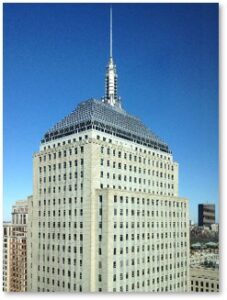Everyone in Boston knows there’s a weather beacon on top of the “old” John Hancock building but few people know when it went up and why. The beacon, like the Citgo Sign and the Steaming Kettle, is a Boston landmark, often consulted and usually taken for granted. Still, it’s only 74 years old, just a spring chicken by the standards of a city founded in 1630.
The Berkeley Street Building
First, the building actually carries the official name of John Hancock Berkeley Street Building—not to be confused with the nearby Berkeley Building on the corner of Boylston and Berkeley Streets.
Designed by the firm of Cram and Ferguson in 1947, this structure might well be called the “middle” or “second” John Hancock Building. The insurance company’s first structure stands at 197 Clarendon Street. Designed by Parker, Thomas and Rice in 1922 it’s known as the Stephen L. Brown Building.
(The third building is the famous Hancock Tower by Henry Cobb of I.M. Pei. In 2005 the company (purchased and renamed Manulife) moved from the Back Bay to a new building at 601 Congress Street in the Seaport District. Three years later it sold that curvy glass structure and returned to the Clarendon and Berkeley Street buildings.)
Where the Clarendon Street building is low and horizontal, this one rises 495 feet and 26 stories. From 1947 to 1964, it held the title of second-tallest building in the city (after the Custom House Tower) but has since fallen off the list of the city’s 20 tallest buildings. It currently comes in at Number 23 but will probably keep dropping as Boston’s buildings reach ever higher.
NOTE: If you stand at the corner of Clarendon and St. James, you can see the Brown and Berkeley buildings reflected in the side of the Hancock Tower for a kind of “family portrait.”
Hancock and Art Deco
The Boston architectural firm of Cram and Ferguson designed the Berkeley Street Building in the Art Deco, style that was popular from approximately 1920 to 1939. That meant it was past the cutting edge of architectural design in the post-World War II period.
The company also designed it to stand out on the Boston skyline, which it did until the 21st century. Both the stepped and truncated pyramid and its famous weather beacon remain instantly recognizable.
The heavily decorated stone façade displays additional Art Deco styling, which can be seen well at ground level. Inside, the Berkeley Street Building houses several meeting and lecture areas in the Back Bay Events Center. This two-part structure includes the John Hancock Hall and the Dorothy Quincy Suite, a full box office, and an 1100-seat auditorium.
The Weather Beacon
In 1950, the company installed a 65-foot tower on the peak of the pyramid. Approximately 288 red and blue lights—originally neon but probably LCDs today — change color to indicate the weather.
The company first lit the Hancock Weather Beacon on March 15, 1950. It indicated weather conditions faithfully until 1973. At that time, the company shut it off to set an example during an energy crisis that also temporarily darkened off the Citgo sign in Kenmore Square. They re-lit the weather beacon in 1983 and it has continued to display the weather forecast ever since.
Engineers in the Berkeley Street Building’s HVAC (heating, ventilating, air conditioning) control room monitor the national Weather Service’s website about every four hours for updates. They adjust the lighting based on the weather forecast using switches that control the operation and color of the lights.
During the Covid-19 pandemic, the light remained steady blue because the Berkeley Street Building was closed. It has since returned to normal operation.
Baseball and the Weather Beacon
Here’s the mnemonic poem that helps viewers to understand what weather is heading our way:
Steady blue, clear view
Flashing blue, clouds due
Steady red, storms ahead
Flashing red, snow instead
During baseball season, flashing red means the Red Sox game has been rained out. The beacon has also flashed red and blue when the Sox clinched a World Series title.
Supposedly, some wag added another line in October of 2004, when the Red Sox won the World Series for the first time in over 80 years:
Flashing Blue and Red, when The Curse of the Bambino is dead!
I don’t buy it. First, the line doesn’t scan with the rest of the poem. Second, it has nothing to do with the weather. A Boston Globe sportswriter invented the fictional curse to sell his eponymous book, which also served to cover up the actual cause of all those lost games: racism and bad hiring on the part of Tom Yawkey. But that’s another whole blog post.
The weather beacon flashed when the Red Sox won the World Series in 2007 and 2013 but not in 2018.
The Weather Beacon: Light and Dark
Once, the Hancock weather beacon kept Boston’s residents up to date before people could watch the six o’clock news on their TVs or check cell phones for the 10-day forecast. It served a real purpose; the way clock towers once gave the time of day to people too poor to own watches or clocks of their own.
As with the Steaming Kettle, we can thank a forward-thinking marketing man for having the idea and making the weather beacon happen. I wonder if he got as much pushback on the cost as marketing people do in the high-tech industry. Regardless, he created visibility for the insurance company and strengthened a company brand that eventually outlived the John Hancock name.
Today, it’s an artifact of an earlier time but we still love it, check out the color, and recite the poem to out-of-towners. The building itself may get little attention but the weather beacon remains a Boston landmark.
We Bostonians love our history, whether recent or distant.

